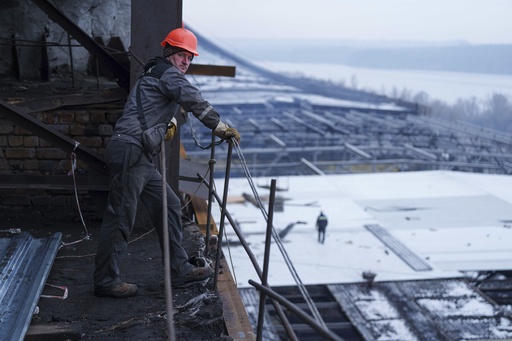
On a sunny winter day, employees at a Ukrainian thermal power facility are engaged in repairing equipment that has suffered significant damage. Water drips from melted snow that seeps through large holes in the facility’s dilapidated roof.
Weeks earlier, the power plant was struck by a Russian air raid that resulted in burn marks, shrapnel damage to the walls, and missile debris spread across the production area. Oleksandr, the 52-year-old head of the Production Management Department, commented on the situation, noting, “This is our life now. Workers at a thermal power facility that should generate electricity are now walking on frozen floors, using firewood for warmth.” For safety reasons, he requested that only his first name be used.
Repeated assaults on infrastructure by Russia have had dire consequences for Ukraine’s energy sector, leading to widespread rolling blackouts throughout the nation. Recently, Moscow executed yet another extensive air assault. Ukrainian officials reported that nearly 200 drones and missiles were deployed against various infrastructure targets, interrupting power supplies for over a million individuals.
The ongoing repair mission for the energy sector is monumental. Since the onset of Russia’s full-scale invasion in 2022, the G7 and other partner nations have contributed over $4 billion to energy support in Ukraine, as stated by U.S. Secretary of State Antony Blinken in September. Oleksandr works at a plant operated by DTEK, Ukraine’s largest private energy corporation. He explained that since the facility was first hit in November 2022, it has struggled to regain full operational capacity due to relentless attacks that have devastated essential equipment. The precise location of the plant and specific details about the damage cannot be shared to prevent aiding Russia in future assaults.
Before the invasion escalated, DTEK was responsible for approximately 20% of Ukraine’s electricity generation. This percentage has since plummeted to 12% as a result of the conflict. The company reported almost 200 attacks from Russia on its facilities since the war began, with around 90% of its infrastructure suffering damage or destruction before a major assault on November 17.
Oleksandr predicts that repair work at the station will extend throughout the winter and into the following year, possibly even longer. The challenge is exacerbated because numerous key components were manufactured during the Soviet era, making it difficult to locate replacement parts. To address this issue, some allied former Soviet countries have provided assistance with equipment supplies.
“Potentially, Western nations might also assist us with equipment, but their power grids have different specifications,” Oleksandr remarked.
Since the initial strikes in November 2022, only half of DTEK’s generating capabilities have been restored ahead of the most recent large-scale attacks. Recently, the European Commission and the U.S. government announced a donation totaling $112 million in construction materials and equipment to aid DTEK as they prepare for the winter.
In the third year of the conflict, DTEK staff have adjusted to the harsh realities of their daily routines. They are well-versed in safety protocols. During air raid alerts, not all personnel can seek shelter, as a skeleton crew must remain in the control room to monitor operations, knowingly putting themselves in harm’s way.
“You have to remain vigilant, tracking the paths of what’s been launched, yet the power units must keep functioning, so we cannot leave our posts,” explained Dmytro, 41, a power unit operator.
Despite the ongoing hardships, Dmytro and his coworkers remain dedicated to their mission of ensuring power is maintained throughout the winter months in their community and surrounding areas.
“Who else will do it if not us? I have a family waiting for me at home, but if we abandon our positions and the equipment fails, we will carry the responsibility, and the city will be left without electricity and heating,” he stated.
“Some are putting their lives on the line at the front lines, while we are battling our own energy crisis here.”
